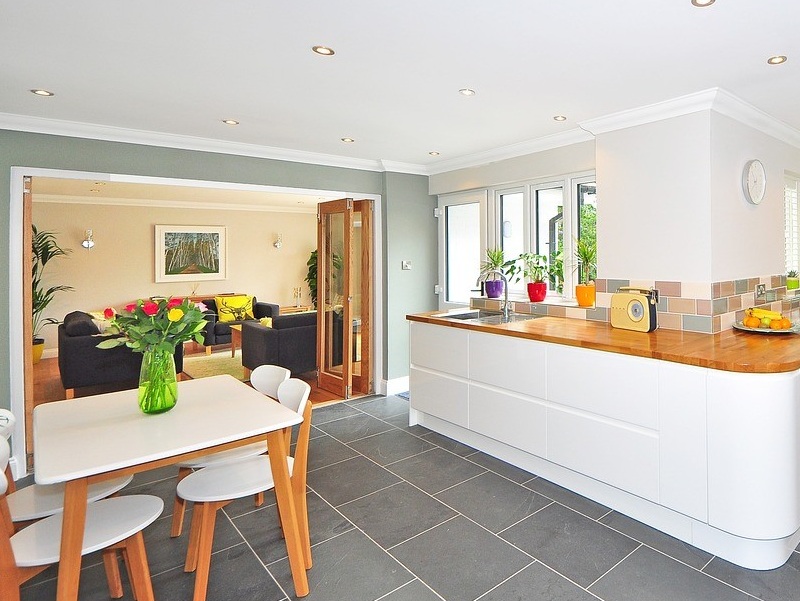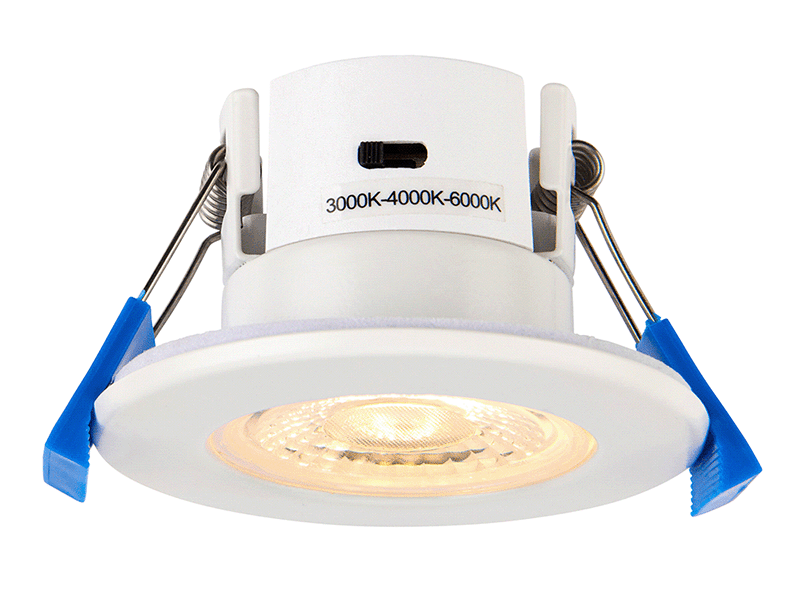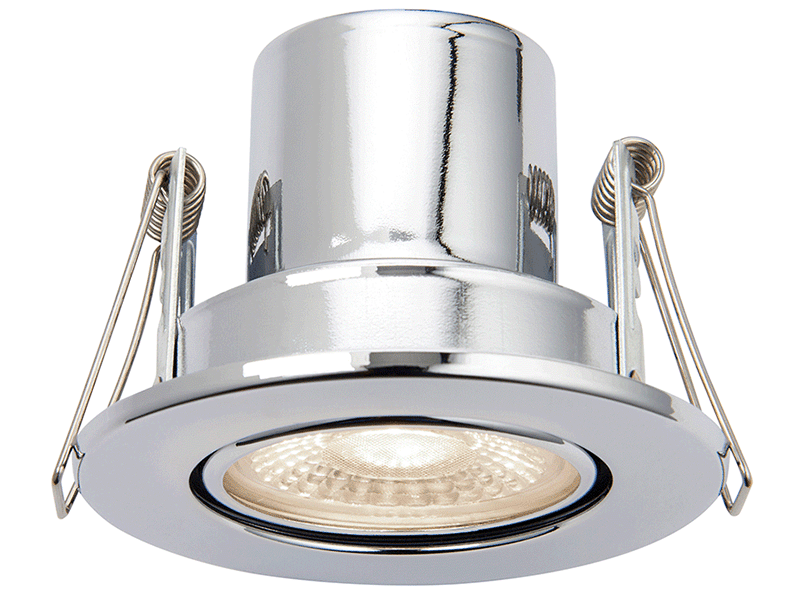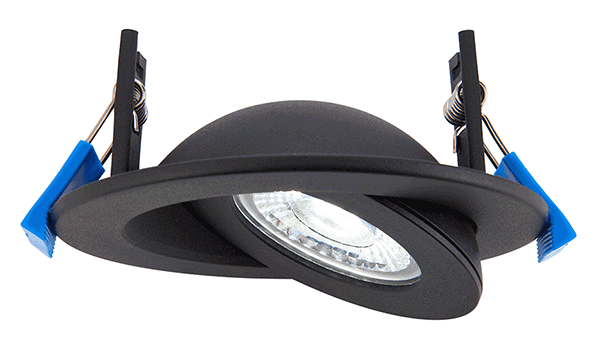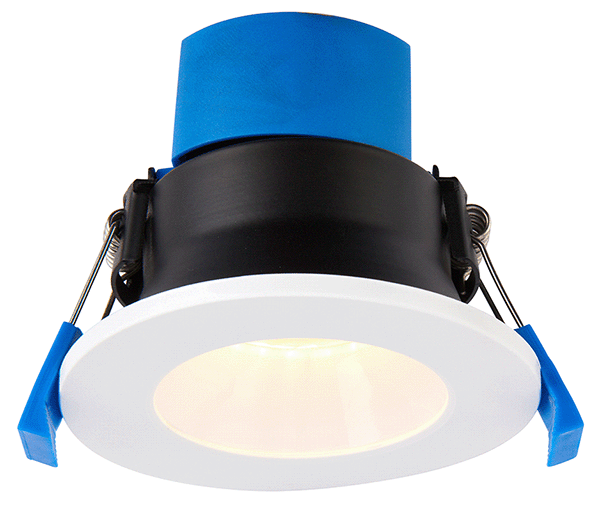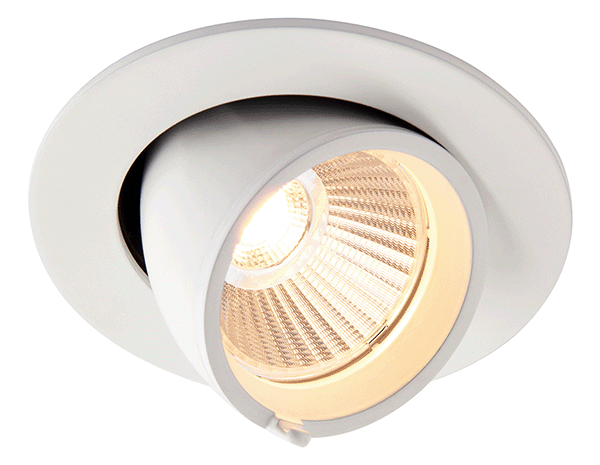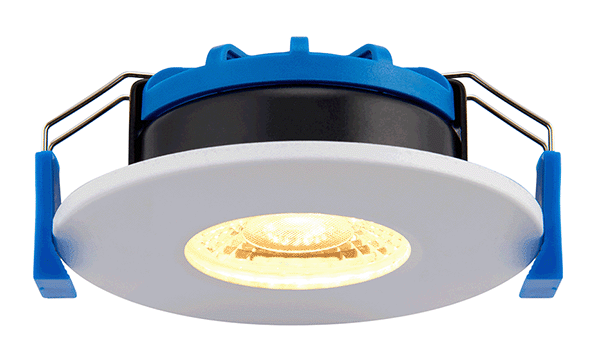Author: Mark Tregunna
10-20 Minute Read – Jump To:
- Introduction
- How to Install Recessed Downlights Safely and Neatly
- Different Types of Downlights and Where to Use Them
- What Beam Angle Do I Need?
- Benefits of LED Downlights
- LED vs GU10 Which Is Right for You?
- What Are Fire-Rated Downlights?
- Are LED Downlights Safe for Bathrooms?
- How to Calculate the Right Number of LED Downlights
- FAQs
A complete Guide to Recessed Downlights
Introduction
Thinking about installing recessed downlights or upgrading to LED downlights in your UK home or workplace? You’re in the right place! This UK guide to recessed lighting will walk you through everything you need to know, from picking the right style and number of lights to understanding important safety features like fire-rated downlights. By the end, you’ll feel confident planning your new lighting setup.
LED recessed downlights aren’t just practical, they’re a stylish way to add soft, even lighting that makes your kitchen, bathroom or hallway shine. Plus, they’re super energy efficient and last way longer than traditional bulbs, saving you money and hassle.
And the best part? You can choose from a range of finishes: white, black, chrome, satin chrome, polished brass, or antique brass. There’s a finish to complement every décor and style.
How to Install Recessed LED Downlights Safely and Neatly
Let’s talk about how these little light fittings are fixed into your ceiling. Most down lighters are made from sturdy pressed steel or cast aluminium with a decorative rim that keeps everything looking neat. They stay put thanks to spring clips or compression clips, think of spring clips like flexible arms that grip the ceiling from the inside, while compression clips have a special latch to hold the light securely.
While DIY friendly, downlights installation in fire-rated ceilings can compromise safety. If you’re unsure, it’s best to call in a professional electrician to help.
Different Types of Downlights and Where to Use Them
-
Fixed LED Downlights
These can have replaceable GU10 bulbs or integrated LED modules and are the most straightforward option, offering a clean, minimalist look. With fixed GU10 LED downlights, the lamp is secured in place using either a twist-lock mechanism or a spring clip. Fixed downlights provide direct downward lighting and are ideal for general ambient lighting.
-
Tilt or Gimbal LED Downlights
Tilt (or gimbal) downlights offer adjustable directionality, allowing you to angle the beam toward specific areas such as worktops, artwork, or shelving. Whether you opt for replaceable GU10 or integrated LED tilt downlights, they are perfect for task lighting in kitchens or accent lighting in living rooms.
-
Anti-Glare LED Downlights
Anti-glare LED downlights are designed to recess the GU10 bulb or integrated LED chip deeper within the fitting, reducing glare and creating a softer, more comfortable light in your room. This makes them ideal where visual comfort is key, such as living rooms, bedrooms, or dining areas. Available with replaceable GU10 bulbs or integrated LEDs, anti-glare downlights offer flexibility in brightness, beam angles, and colour temperatures, ensuring a personal lighting experience with minimal eye strain.
-
Wall Washer Downlights
Designed to cast light across a wall rather than straight down, wall washer downlights are mounted in the ceiling and feature an internal tilt mechanism. They are perfect for highlighting feature walls, alcoves or artwork. Integrated LED wall washer downlights are available in a variety of finishes and lumen outputs for flexibility.
What Beam Angle Do I Need for LED Downlights?
When choosing LED downlights, one important factor that is often overlooked is the beam angle. This refers to the spread of light from the fitting or the GU10 bulb and will have an impact on how your room is illuminated. These are the most popular types used today:
- Narrow Beam Angle (usually around 25 degrees): These are best for task lighting and concentrate light in a smaller area to highlight or accentuate features like artwork or statement furniture.
- Medium Beam Angle (usually around 38 degrees): A good spread of light, these are the most popular choice for general lighting without being too focused or wide.
- Wide Beam Angle (60 degrees to 120 degrees): Great for ambient lighting in an open plan setting or in rooms with low ceilings where a softer light is desired.
Using the correct beam angle helps reduce the number of lights required, avoids harsh shadows and ensures an evenly lit room. Always consider the height of your ceiling, as higher ceilings may benefit from narrower beams and lower ceilings work better with wider beams.
Benefits of LED Downlights Over Traditional Lighting
LED (Light Emitting Diode) technology has completely transformed modern lighting. LED downlights are now the go to choice for recessed lighting due to their many advantages:
Benefits of LED Downlights
- Long Life: These lights last and last, with integrated LEDs often giving over 25,000 hours. GU10 bulbs often last up to 20 times as long as traditional halogen bulbs. That means fewer bulb changes and more peace of mind.
- Cool Operation: Unlike halogens, LEDs don’t get hot, so they’re safer and reduce fire risks.
- Colour Choice: Want a cosy warm glow or bright daylight? You’ve got options!
- Dimmable: Many models work with dimmer switches, so you can set just the right mood. Ensure your GU10 bulbs are rated as dimmable or that your integrated LED downlights are compatible with the dimmer you are using.
- Smart Control Compatibility: Many modern LED downlights can be paired with smart home systems like Alexa or Google Home. That means you can control your lighting using your voice, your phone, or even schedule it to switch on automatically, perfect for security and convenience.
- Sustainable Lighting Choices: Looking to make greener choices? LED downlights already use up to 90% less energy than traditional bulbs, but many also feature recyclable components and plastic-free packaging. Always check the specs, eco-friendly lighting is perfect for your home and the planet.
When it’s time to replace your LED, take it to your local recycling centre – most now accept LED bulbs for proper disposal.
Whether you pick integrated LED downlights or ones with replaceable GU10 bulbs, you’ll enjoy sleek looks and smart heat management that keeps your lights running smoothly.
Integrated LED vs GU10 Downlights – Which Is Right for You?
When choosing LED recessed lighting, one of the most important decisions is whether to go for integrated LED downlights or replaceable GU10 downlights. Each option has its own advantages, depending on your installation and budget.
Integrated LED Downlights
These fittings have a built-in LED chip that is not serviceable, meaning the entire fitting is swapped when it eventually reaches its end of life (which is typically 25,000 to 50,000 hours). Features include:
- Slim, compact designs – ideal for shallow ceiling voids
- Excellent heat management – improves lifespan and performance
- High energy efficiency – lower running costs over time
- Dimmable and smart options – compatible with most smart control systems
- Longer life expectancy – perfect for inaccessible areas
Best for modern builds, new kitchens or bathrooms, or minimalist ceiling designs where long life and low maintenance are key.
Explore our integrated LED downlight collection
GU10 Downlights (Replaceable Bulbs)
GU10 downlights use a standard GU10 LED bulb, which can be replaced independently of the fitting. This gives you greater flexibility to customise your lighting setup over time.
- Easy to maintain – just replace the bulb when needed
- Wide bulb compatibility – choose from different wattages, beam angles, and colour temperatures
- Lower upfront cost – budget-friendly for renovations
- Suitable for retrofit projects – works with existing GU10 wiring and cut-outs
- Available in a wide range – fixed, adjustable, and fire-rated designs
- Long lifetime – the bulb can be changed when it fails rather than dispose of the whole fitting
Best for retrofits, property developers, or anyone who wants the option to switch bulbs later.
Shop our GU10 downlights
So… Which Should You Choose?
If you want a sleek, future-proof option with minimal maintenance, integrated LED downlights are hard to beat. But if you’re after easy upkeep and more control over your light output, GU10 downlights give you added flexibility and value.
Whichever you choose, both options are available in fire-rated, IP-rated, and dimmable versions, so you’ll always find a model to suit your project.
What Are Fire-Rated Downlights and Do I Need Them?
Once you cut into a ceiling to install a downlight, you compromise the fire barrier between floors. Fire rated LED downlights are designed to restore this protection. They include an intumescent strip that expands under high heat, sealing the hole and delaying fire spread.
What are fire ratings, and why are they required?
Fire ratings measure how long a building’s structural elements, like floors and ceilings, can withstand fire before failing. In the UK, fire ratings are mandated by building regulations to ensure homes meet strict safety standards. The primary goals are:
- Prevent Rapid Fire Spread: Fire rated downlights slow the spread of flames, giving occupants time to evacuate safely.
- Reduce Fire Severity: They limit fire size, reducing risks to residents, the emergency services, and nearby properties.
- Protect Structural Integrity: Fire-resistant materials help maintain a building’s stability during a fire, preventing collapse.
For homeowners, understanding fire ratings is key to ensuring your home is safe and compliant with regulations, especially in multi-storey properties.
Fire Ratings for UK Homes
Two Storey Homes
In a typical two-storey UK home with living spaces on both floors, the floor/ceiling construction (wooden floors with plasterboard ceilings) must achieve a minimum 30-minute fire rating. This ensures:
- Safe Evacuation: 30 minutes provides critical time for occupants to escape if a fire starts.
- Fire Containment: Slowing fire spread reduces damage and danger to firemen and neighbours.
Three Storey Homes or Loft Conversions
In homes with three storeys or a converted loft used as a bedroom, the fire rating requirement increases to 60 minutes. The additional time accounts for the greater distance occupants may need to travel to evacuate safely from higher floors.
Loft Spaces without Living Areas
If the loft is unused or not a living space, no fire rating is required. However, installing fire-rated downlights is still recommended. These can prevent fire from spreading to the roof structure, which could compromise the entire building’s safety.
Key Takeaways for Homeowners
- Check Your Home’s Fire Rating: Two-storey homes need a 30-minute fire rating for floor/ceiling constructions, while three-storey homes or loft conversions require 60 minutes. Properties such as flats or taller buildings may require 90 minutes or more.
- Use Fire-Rated Downlights: These maintain the fire barrier in ceilings, preventing rapid fire spread.
- Consult Professionals: When renovating or installing downlights, work with qualified electricians or builders to ensure compliance with fire safety regulations.
- Consider Extra Precautions: Even in non-living loft spaces, fire-rated downlights add an extra layer of safety.
Fire Resistance Minimum Requirements
| Type | Basement (Up to 10m depth) |
Ground Floor and Above Height of Top Floor |
||||
|---|---|---|---|---|---|---|
| Up to 10m | Single Storey | Two Storey or up to 5m | Three Storey up to 18m | 18m–30m | 30m+ | |
| Residential | 30 minutes | 30 minutes | 30 minutes | 60 minutes | ||
| Institutional | 60 minutes | 30 minutes | 30 minutes | 60 minutes | ||
| Flat | 60 minutes | 30 minutes | 30 minutes | 60 minutes | 90 minutes | 120 minutes |
Not sure which fire-rated option is right for you?
Speak to one of our lighting specialists for free, friendly advice or explore our Fire Rated Downlights section for peace of mind and full compliance.
Are LED Downlights Safe for Bathrooms? IP Ratings Explained
Bathroom lighting must comply with strict safety regulations. LED downlights used in bathrooms need to be appropriately IP rated to protect against moisture.
- Zone 1 (above the shower or bath): Requires IP65 minimum.
- Zone 2 (0.6m outside of Zone 1): IP44 or higher is suitable.
Always check the manufacturer’s specifications, and if you’re unsure, consult a qualified electrician or call us on 0151 650 2138, we’re here to help.
Shop Bathroom Downlights
How to Calculate the Right Number of LED Downlights for Your Room
This is one of the most frequently asked questions, and it depends on factors like room size, ceiling height, and intended use.
As a general rule for ambient lighting:
- Standard rooms: Space LED downlights between 1.3m – 1.7m apart in every direction.
- First downlight: Position it 0.8m to 1m away from the wall to avoid harsh light streaks down the wall.
- Task or accent lighting: Consider closer spacing or using adjustable downlights and narrower beams for focused lighting.
LED lighting layouts should always consider joist positioning, insulation type, and room usage. Or give us a call on 0151 650 2138 for personal advice.
Got more questions? You’re not alone, here are the most common things people ask before they buy.
FAQs: Everything You Need to Know About Recessed Downlights
Q1)What warranties do your downlights usually come with?
A) Most dedicated LED brands offer 2 to 5-year warranties covering defects and performance. For GU10 downlights, the fitting is guaranteed for 2 years and the GU10 bulbs we supply are guaranteed for 2 years. Check the warranty terms on the product page for peace of mind.
Q2) What are fire-rated downlights and do I need them?
Fire-rated downlights maintain ceiling fire barriers, preventing rapid fire spread. Two-storey homes typically require 30-minute ratings, while three-storey homes or loft conversions need 60 minutes or more.
Q3) Is it safe to install downlights in ceiling with loft insulation?
A) Yes, but ensure that you use IC (Insulation Contact) rated downlights designed to be safely covered by insulation. Alternately, you can use fire hoods or insulation covers protect non-IC rated fittings. Always ensure compliance with fire safety regulations by consulting a professional.
Q4) How long do LED downlights typically last?
A) This varies between different fittings and will depend on the bulbs you select. The average life is usually stated on the outer packaging of the light or the bulb. Some LEDs can last up to 50,000hours which will give approximately 17 years of life with average daily use.
Q5) Can I replace my old halogen downlights with new versions?
A) Yes. Often it is as easy as just replacing the bulb if your existing downlights use GU10 cap halogens as there are many GU10 LED bulbs now available. If you are intent on changing for new fittings, take a note of the hole cut out size and select new downlights which will fit the aperture in your ceiling, or let us know the hole size and we can send you a list of compatible downlights.
Q6) Are downlights suitable for low ceilings?
A) Yes, their flush design makes them ideal for lower ceilings offering ample light without compromising headroom.
Q7) Should I choose IP rated downlights for my kitchen?
A) For areas exposed to moisture such as bathrooms and kitchens, it is best practice to choose an IP rated downlight to prevent water or steam ingress.
Q8) Can I dim LED recessed downlights and what do I need for that?
A) Yes, many LED downlights are dimmable. Ensure you use an LED compatible dimmer switch (usually trailing edge) to avoid flickering for a smooth dimming performance. We always stock British made dimmer modules that we guarantee will work.
Ready to Choose Your Downlights?
Quick Tips Before You Buy:
- Check your ceiling type and cut-out size
- Choose fire-rated if required
- Decide fixed vs adjustable
- Pick a finish to match your décor
- Go smart if you want voice/app control
- Choose a beam angle that suits your room layout
Our collection includes dedicated LED fixtures, fire-rated downlights and stylish GU10 downlights. Still got questions or want a bit of friendly advice? No worries! Just give us a call at 0151 650 2138 or send a message via our contact us form. Our lighting experts are always happy to help you find the perfect recessed downlights to brighten your space beautifully and safely.



